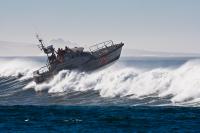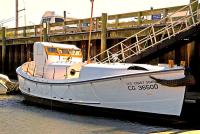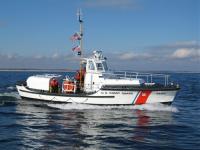
47′ Motor Lifeboat
It takes a special breed of sailor to attempt to crest the monstrous waves of a harbor bar in a motor lifeboat. It also takes a very specially designed and built boat to make crossing the bar possible. We recently reviewed the movie, “The Finest Hours,” which told the story of the what is considered by many to the greatest small boat rescue in history. In 1952, coxswain Bernie Webber with a crew of three took CG-36500, a 36-foot motor lifeboat, across Chatham bar in a winter Nor’easter to rescue the crew of the T2 tanker SS. Pendleton, which had broken in half in the storm.
When large ocean swells hit sand bars at a harbor entrance, the resulting breaking waves can rise to monstrous heights. Most fishermen and other boatman stay in port. When a ship or boat is in danger offshore, however, the Coast Guard has no choice but to go out and in many cases, a motor lifeboat is the only way to get the job done. The boats are designed to be self-righting and to survive the worst the sea can throw at them. A brief overview of these amazing boats.
36-Foot Motor Lifeboat, 1929-1963/1987
 The motor lifeboat that Bernie Webber and his crew used to save the crew of the Pembleton was a 36′ wooden lifeboat, introduced in 1929. Two hundred and eighteen of these boats were built. CG-36500, the boat used in the Pembleton rescue, has been preserved and is maintained by the Orleans Historical Society Rock Harbor in Orleans, Massachusetts. the 36′ lifeboats began to be phased out in 1963 with the introduction of the 44′ motor lifeboat. The last 36′ motor lifeboat was retired in 1987.
The motor lifeboat that Bernie Webber and his crew used to save the crew of the Pembleton was a 36′ wooden lifeboat, introduced in 1929. Two hundred and eighteen of these boats were built. CG-36500, the boat used in the Pembleton rescue, has been preserved and is maintained by the Orleans Historical Society Rock Harbor in Orleans, Massachusetts. the 36′ lifeboats began to be phased out in 1963 with the introduction of the 44′ motor lifeboat. The last 36′ motor lifeboat was retired in 1987.
44-Foot Motor Lifeboat, 1963-1997
 From the U.S. Coast Guard History Program:
From the U.S. Coast Guard History Program:
Probably one of the most legendary boats that was ever introduced into American coastal rescue service was the 44’ motor lifeboat. The 44’ motor lifeboat is a unique craft in the overall development of American coastal lifeboats, having been used successfully for the past forty-two years around the
nation, as well as having had a worldwide influence on search and rescue craft designs. The development of the 44-footer is a prime example of a vessel being designed for very specific conditions, translating design concepts of seaworthiness, ease of handling, speed, weight, draft, strength and capacity into a much-loved boat that Coast Guard crews speak of in almost reverent
tones.
47-foot Motor Lifeboat, 1997 to Present
From the USCG 47-foot Motor Lifeboat (MLB):
The 47-foot MLB was the replacement vessel of the circa 1963-1972 44-foot MLB. Is is primarily designed as a fast response rescue in high seas, surf, and heavy weather environments to operate in up to 30FT seas, 20FT surf, and winds up to 50 knots. With safety in mind, 13 water-tight compartments were constructed. Similar to the 44-foot MLB, the 47-foot MLB can self-right in only 30 seconds. With state of the art electronically controlled engines, fuel management systems and integrated electronics suite, including 4 coxswain control stations, the 47-foot MLB has become the ideal platform for operations in extreme at seas weather conditions. With construction completed, 117 47-foot MLBs are in service throughout the Coast Guard Rescue Station community, serving the public.
Coast Guard 47-foot Motor Lifeboat in the Surf near Ilwaco, Wash.

The 47′ MLB didn’t come into service until the 1990’s.
R,
You are exactly right. My mistake. I fixed it. Thanks for pointing it out.
If I remember correctly, although the 47′ MLB was first built in the late ’80s, it went through nearly a decade of Sea Trials, Training Missions (Most notably in Prince William Sound due to the frequent severe conditions) as well as extensive rounds of improvements before it was actually deployed for service throughout the USCG.